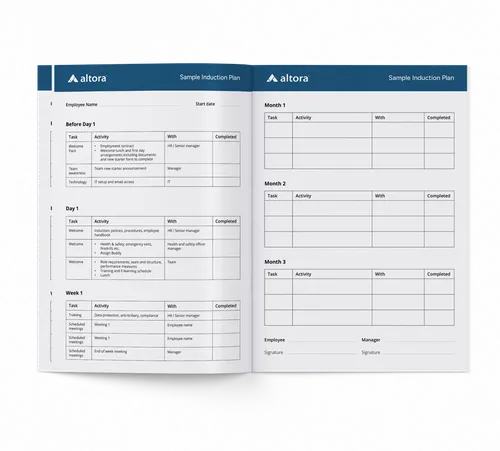The Ultimate Guide to Creating an Effective Employee Induction Plan
Grace Clueit 7 min readMaster the essential steps for effective employee onboarding with our comprehensive induction plan. Read on to enhance your onboarding process today!

A solid and well thought out induction is so important for setting up your employees for success and ensuring they are well informed and trained for long term results. It’s one of the most important steps in the onboarding process.
This guide will equip you with with everything your induction might need - from essential criteria such as health and safety regulations to training, plus a checklist to get them started immediately.
What Is an Induction Plan?
An induction plan is a structured document and process for new employees, helping to inform, guide and integrate them into the company and culture.
It’s a comprehensive program with many elements that aims to not only serve new employees on their first day but also to ensure ongoing success throughout their tenure with you.
Download template
Why an Induction Plan Is Important
A detailed, tailored and well-executed induction plan is vital for a number of reasons:
Key Components of an Induction Plan
Here are the essential elements that every successful new employee induction program should include:
Company Mission, Values, and Culture
Help your new hire feel welcome and connected with the company by sharing details about your mission, vision, values and the company’s history. Tell them interesting facts or qualities about other team members, discuss team events, awards and recognition. Share the organisational structure so they have a clear picture of where they sit, who they report to and who reports to them.
The Role, Responsibilities, and Expectations
Discuss the day to day duties of the role and responsibilities. Share targets and KPIs (individual and team/company), and how their role fits into the larger team. Discuss clear milestones you’ll be working towards over the coming weeks.
Essential HR Policies and Procedures
Share important company policies and procedures and general information such as access codes, contracts, building map, the company’s code of conduct, leave policies. Share the updated employment contract if you’ve not already done so. This is a great opportunity to get your new employee to fill out any forms required such as payroll bank details, ID and any other HR paperwork.
Workplace Health and Safety (WHS)
Ensure you cover all WHS requirements and protocols within your induction process. Let new employees know emergency plans and exits, and ensure all WHS documentation has been completed and understood.
Team Introductions
Schedule team introductions, let them know who the department heads are for each area, practical orientations and observation time if relevant. Ensure you spend time introducing your new staff member to their colleagues one-on-one so it’s not too overwhelming and they can begin to get to know them.
Getting Set Up: IT, Systems, and Facilities
Ensure all log in details, access codes and equipment are set up and ready. Talk your new employee through the systems and allow them to have some practical time getting to know how everything works, plus a follow up with time to ask questions or flag any queries.
Learning and Development Opportunities
Let your new employee know about any learning and development opportunities such as expanding their skillset, experience in other departments, additional courses, certifications and training.
Induction Training
Map out your induction training plan for your new team member. Keep it engaging and diverse, allowing new starters to absorb the knowledge at their own pace and in a way that suits their learning style.
Review and Feedback Schedule
Ensure you have a review and feedback schedule pencilled in. This not only allows you to share feedback with them on their initial performance, but also to find out if additional training is required and allow your new hire to share any feedback or improvements for the overall induction process. This allows you to ensure your induction program is constantly evolving.
Induction Plan Best Practices
Here are our induction plan best practices which are crucial for making new employee inductions effective and engaging.
Pre-Boarding: Engage Before Day One
Engaging your new hire prior to their first day is a great way of making them feel excited, valued and reduces nerves. Consider sending them an email with a welcome pack and a bit about the company and what their first week is going to look like so they can mentally prepare. Let them know start/finish times for the week along with helpful tips such as where to buy lunch (or whether you’re taking them for lunch!) and where the best coffee is.
Establish Regular Check-ins for Feedback and Support
Ensure you check in regularly with your new hire to allow time for support and feedback. It can be overwhelming starting a new role so it’s important to keep in close contact over the first few weeks, and host regular check-ins for continuous improvement. This will help them feel supported and will help you establish if further training is required.
Make Learning Interactive and Engaging
Keeping learning and training engaging is a game changer. We now have a plethora of options that help you make your training more interesting and interactive - from quizzes to Q&A sessions, videos, group activities and hands-on tasks. Find out what your new employee’s learning style is and tailor your training to suit. For example, a kinaesthetic learner learns by doing so prefers a more active and hands-on-task (they might not absorb information well by solely listening) so it’s important to factor this in.
Use Technology to Streamline the Process
Take advantage of technology and streamline the process. An induction platform such as Altora’s helps you induct your workforce with ease via a secure link. Deliver information consistently and efficiently, collect and store all worker documentation, and access powerful reporting capabilities. Send the link prior to commencement and your new employees can begin their induction remotely.
Foster Social Connections and Team Integration
Team integration is an integral part of an induction. Consider organising a casual lunch with team members, assigning an onboarding buddy and one-to-one team introductions to help them settle in and feel at ease.
Set Clear Expectations and Maintain Communication
It’s so important to set clear expectations for the role and throughout your induction program. Ensure consistent messaging, be as transparent as possible and maintain communication.
Induction Plan Timeline (First Week Example)
| Day | Activity |
|---|---|
| Day 1 | HR welcome Office tour Lunch with manager Systems overview |
| Day 2 | Meet the team Altora online training module Lunch Coffee with marketing manager Self learning/system exploration |
| Day 3 | Role shadowing Lunch Coffee with finance manager Self learning/system exploration |
| Day 4 | Altora online training modules Lunch Role shadowing Self learning/system exploration |
| Day 5 | Coffee with sales manager Altora online training modules Lunch with team Self learning/system exploration |
Bring Your Plan to Life with an Induction Checklist
An induction checklist is a great place to start and helps you ensure you’ve covered everything you need to, and no crucial steps are missed.
Our free induction checklists are written by industry experts, ensuring they are accurate, up-to-date and ready to use. We have a range of checklists for you to access.

Grace Clueit
Marketing Manager
This article was written by Grace Clueit, Altora’s Marketing Manager. Grace has significant experience in marketing and writing.
This content was 100% human-created.